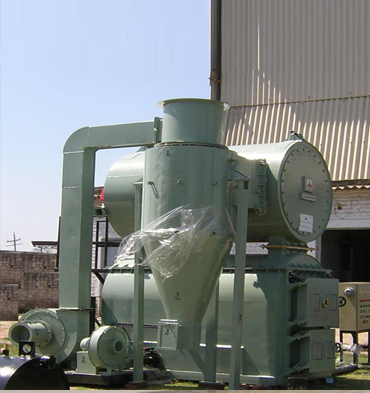Welcome to factory & industry business
Cyclone
Product Description
Cyclone separator is a method of removing particulate from an air, gas or liquid stream without the use of filters, through vortex separation. Rotational effects and gravity are used to separate mixtures of solids ands fluids. The method can also be used to separate fine droplets of liquid from a gaseous stream. A high speed rotating (air) flow is established within cylindrical or conical containers called a cyclone. Air flows in a helical pattern, beginning at the top (wide end) of the cyclone and ending at the bottom (narrow) end before exiting the cyclone in a straight stream through the centre of this cyclone and out the top. Larger (denser) particles in rotating stream have too much inertia to follow the tight curve of fall to the bottom of the cyclone where they can fall to the bottom of the stream, and strike the outside wall, then fall to the bottom of the cyclone where they can be removed. In a conical system, as the cyclone, the rotational radius of the stream is reduced, thus separating smaller particles. The cyclone geometry, together with flow rate, defined the cut point of the cyclone. This is the size of particle that will be removed from the stream with 50% efficiency. Particles larger than the cut point will be removed with a greater efficiency and smaller particles with a lower efficiency.
An alternative cyclone design used a secondary air flow within the cyclone to keep the collected particles from striking the Walls, to protect them from abrasion. The primate air flow containing the particulars enters from the bottom of the cyclone and in forced into spiral rotation by stationary Spinner vanes. The secondary air flow enters from the top of the cyclone and move downward the bottom, intercepting the particulate from the primary air. The secondary air flow also allows the collector to optionally be mounted horizontally because it pushes the
particulate towards the collection area, and does not rely solely on gravity to perform this function . Large scale cyclones are used in sawmills to remove sawdust from extracted air. Cyclones are also used in oil refineries to separate oils and gases, and in the cement industry as component of kiln pre-heaters. Cyclones are also used in industry rial and professional kitchen ventilation for separating the grease from the exhaust air in extractions hoods. Cyclones are increasingly used in the house hold, as the core technology in bag-less. Despite its simple operation, the fluid dynamics and flow structures in a cyclone separator are very complex. This equipment is a setting chamber in the form of a vertical cylinder, so arranged that the particles laden air spirals round the cylinder to the outside wall. Cyclones are very popular because there are no moving parts that can wear out or break, with no moving part involved and mainly consisting of a drum with a funnels on the bottom and inlet including export. In the agricultural processing industry, 2D2D (Shepherd and Lapple, 1939) and 1D3D (Parnell and Davis, 1979) cyclone designs are the most commonly used abatement devices for particulate matter control. The D’s in the 2D2D



